About Mountain Gorillas
Gorillas in general are believed to have evolved from monkeys and other apes in Arabia and Africa about 9 million years. After a period of time (About 2 million years ago), Eastern gorillas separated from the western gorillas in west and central Africa. The eastern gorillas further split into what we now know as mountain gorillas and eastern lowland gorillas 400,000 years ago.
The name gorilla was adopted in 1852 after the genus were first called Troglodytes. In 1967, Colin Groves came up with the idea of giving different names to the different species of gorillas and that is how the name western lowland gorilla, eastern lowland gorilla and the mountain gorilla came to be.
Where are Mountain Gorillas found?
Mountain gorillas are only found in three countries – Uganda, Rwanda and the Democratic Republic of Congo. Uganda has about half of the overall population in Bwindi Impenetrable National Park and Mgahinga Gorilla National Park. In Congo, the mountain gorillas are found in Virunga National Park while in Rwanda you can find 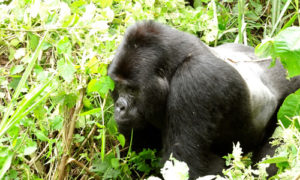 them in the Volcanoes National Park. These areas provide the right habitat, ecology and altitude (7,200–14,100 feet) to allow the mountain gorillas thrive. The high altitude supports dense vegetation, are cold and cloudy. Lowland gorillas (Eastern and Western) are found in the Democratic Republic of Congo, Cameroon and other countries in west and central Africa. The overall population of western lowland gorillas is over 250,000 while the eastern lowland gorillas are less than 8,000. One of the reasons why mountain gorillas are given so much attention is because they cannot survive in captivity like the lowland gorillas. The last gorilla census in 2018 found that about 1,004 mountain gorillas still roam the planet. For this reason, the mountain gorilla is listed as endangered by the IUCN. You might want to look at some facts about mountain gorillas in our shorter article.
them in the Volcanoes National Park. These areas provide the right habitat, ecology and altitude (7,200–14,100 feet) to allow the mountain gorillas thrive. The high altitude supports dense vegetation, are cold and cloudy. Lowland gorillas (Eastern and Western) are found in the Democratic Republic of Congo, Cameroon and other countries in west and central Africa. The overall population of western lowland gorillas is over 250,000 while the eastern lowland gorillas are less than 8,000. One of the reasons why mountain gorillas are given so much attention is because they cannot survive in captivity like the lowland gorillas. The last gorilla census in 2018 found that about 1,004 mountain gorillas still roam the planet. For this reason, the mountain gorilla is listed as endangered by the IUCN. You might want to look at some facts about mountain gorillas in our shorter article.
Physical Characteristics of Mountain Gorillas
Mountain gorillas are characterized by a thicker fur compared to all the other types of gorillas in Africa. This allows them to live in cold higher altitudes. Adult male mountain gorillas are known as silverbacks because of the silver hair behind 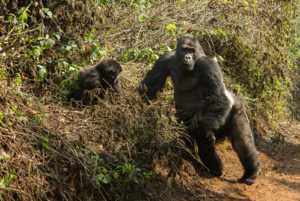 their back. An adult female gorilla weighs about 100 kilograms while a silverback gorilla can weigh about 195 kilograms. Silverbacks are also taller and four times stronger than the largest human. However, Mountain gorillas generally weigh less and is smaller than the eastern lowland gorilla. The largest lowland gorilla ever recorded was shot in Cameroon and weighed 267 kilograms. Like all other gorilla species, mountain gorillas can be identified by the unique nose prints of each individual. They have eyes that are dark brown and hands that are longer than the legs. Mountain gorillas can stand and move upright but they prefer knuckle-walking where they use their fingers to support their weight. Mountain gorillas are active only during the day (6:00 am to 6:00 pm). Most of this time is spend feeding on insects, shoots/stems, leaves, roots, flowers and fruits to sustain their large size. The most active eating time is in the morning, then a rest around mid-day before eating again in the afternoon as night approaches. The rest period at mid-day is an opportunity for bonding through grooming to remove parasites and dirt. This is also the time when you can witness juveniles playing, chasing, somersaulting and wrestling. Adults may participate in the games if invited though grudgingly. At all times group members use barks and grants to locate individuals within the thick vegetation. As night approaches, each adult individual builds a nest from tree leaves and other vegetation. Infants share the same nest with their mothers.
their back. An adult female gorilla weighs about 100 kilograms while a silverback gorilla can weigh about 195 kilograms. Silverbacks are also taller and four times stronger than the largest human. However, Mountain gorillas generally weigh less and is smaller than the eastern lowland gorilla. The largest lowland gorilla ever recorded was shot in Cameroon and weighed 267 kilograms. Like all other gorilla species, mountain gorillas can be identified by the unique nose prints of each individual. They have eyes that are dark brown and hands that are longer than the legs. Mountain gorillas can stand and move upright but they prefer knuckle-walking where they use their fingers to support their weight. Mountain gorillas are active only during the day (6:00 am to 6:00 pm). Most of this time is spend feeding on insects, shoots/stems, leaves, roots, flowers and fruits to sustain their large size. The most active eating time is in the morning, then a rest around mid-day before eating again in the afternoon as night approaches. The rest period at mid-day is an opportunity for bonding through grooming to remove parasites and dirt. This is also the time when you can witness juveniles playing, chasing, somersaulting and wrestling. Adults may participate in the games if invited though grudgingly. At all times group members use barks and grants to locate individuals within the thick vegetation. As night approaches, each adult individual builds a nest from tree leaves and other vegetation. Infants share the same nest with their mothers.
Mountain gorillas spend most of their time on the ground. Their nests are also built on the ground. Adult gorillas will only climb trees in search of fruit and if the tree can hold their weight. Frequent tree climbing is left to the juveniles. One of the frequent cause of accidents and even death among adult gorillas is falling off a loose tree branch. Mountain gorillas are afraid of certain insects and reptiles. It is not understood why but they avoid caterpillars and chameleons if they can. Mountain gorillas are also afraid of water and dislike rain. They will only cross streams if they can cross it using fallen trees/logs. One of the things that separate gorillas from other primates is their relatively stable groups. Mountain gorillas in particular are high social and leave in a cohesive group led by a dominant male. They are held together for longer periods than other ape families because of the close bond between the dominant silverback and females. The bond between females is weaker and they will often leave to join other gorilla groups once they reach maturity. Females that leave the group on maturity will join another prominent group or start life with a lone male. Some females will change to new groups several times before sticking to one silverback. Most of the females in a group will remain loyal 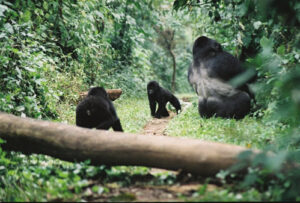 to the dominant silverback for life. Mating in mountain gorillas is often initiated by a fertile female. Mountain gorilla groups do not control or inhabit a particular territory leaving the male silverback with the task of only defending his group against intruders. 36% of mountain gorilla groups contain more than one silverback. A few groups contain only males led by an older adult but there are also lone males. In a gorilla group with females, the dominant male silverback is the undisputed leader and center of attention while the rest of the males are subordinates. Everyone in the group tries to be on his good books by behaving well and involving him in their games if he shows interest. He dictates the movement of the group and chooses the best feeding grounds. A silverback resolves any conflicts between members and will defend the group against other gorillas, leopards or humans even to the death. When a female dies or leaves the group, the silverback will take care of her young. He can use his experience to remove snares from the feet or hands of members of his group. The death of a silverback can cause disruption in a once peaceful group. If there is no acceptable leader to succeed the silverback, the group will split or get a leader from outside the group. If they choose a silverback from another group, there is a risk that he may decide to kill all infants of the deceased male. Mountain gorillas may be strong and powerful but they are generally very gentle and shy. The group members only resorts to aggression when attacked or if they encounter another group of gorillas. Even in such cases, they will first begin by threating or intimidating an intruder. When the Silverbacks choose to fight, it can turn out to be violent even to the point of death. They will use their sharp teeth to cause deep wounds and injuries and to the rival.
to the dominant silverback for life. Mating in mountain gorillas is often initiated by a fertile female. Mountain gorilla groups do not control or inhabit a particular territory leaving the male silverback with the task of only defending his group against intruders. 36% of mountain gorilla groups contain more than one silverback. A few groups contain only males led by an older adult but there are also lone males. In a gorilla group with females, the dominant male silverback is the undisputed leader and center of attention while the rest of the males are subordinates. Everyone in the group tries to be on his good books by behaving well and involving him in their games if he shows interest. He dictates the movement of the group and chooses the best feeding grounds. A silverback resolves any conflicts between members and will defend the group against other gorillas, leopards or humans even to the death. When a female dies or leaves the group, the silverback will take care of her young. He can use his experience to remove snares from the feet or hands of members of his group. The death of a silverback can cause disruption in a once peaceful group. If there is no acceptable leader to succeed the silverback, the group will split or get a leader from outside the group. If they choose a silverback from another group, there is a risk that he may decide to kill all infants of the deceased male. Mountain gorillas may be strong and powerful but they are generally very gentle and shy. The group members only resorts to aggression when attacked or if they encounter another group of gorillas. Even in such cases, they will first begin by threating or intimidating an intruder. When the Silverbacks choose to fight, it can turn out to be violent even to the point of death. They will use their sharp teeth to cause deep wounds and injuries and to the rival.
Dian Fossey and her research on Mountain gorillas
The first person to identify the mountain gorilla was Captain Robert von Beringe while on an expedition to establish the boundaries of the then German colonies in East Africa. After shooting two of the large apes, one was captured and sent to a museum in Germany. It was here that a new gorilla species was discovered. It was named Gorilla beringei after the captain Robert. In the following decades, several researchers took interest in studying this new species including George Schaller in 1959 and Dian Fossey in 1967. Fossey took Mountain gorilla research to an unprecedented level and is credited for discovering new ways of habituating mountain gorillas like mimicking their sounds and gaining the trust of the dominant male silverback. She organized the first gorilla census and changed from focusing solely on research to gorilla conservation hence bringing to the attention of the world the plight of the gorillas. 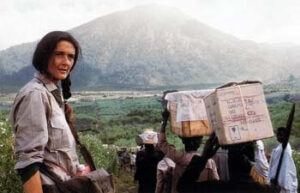 Dian Fossey divided gorilla conservation into three areas – Active, theoretical and community-based. Under active conservation, she suggested the need to proactively enforce laws that were against poaching including destroying poacher equipment, carrying out animal censuses. Theoretical conservation would require improving the infrastructure around gorilla habitats including renovating park offices, lodges and habituating gorilla families to encourage tourism. The final approach to gorilla conservation is the community based conservation approach where communities are involved and their interests taken into consideration. Fossey actively fought against poachers by sabotaging their operations and starting park patrols. Her brutal murder is believed to have been a result of her hard line against poachers. Her work continues to this day through what is now known as the Dian Fossey Gorilla Fund International.
Dian Fossey divided gorilla conservation into three areas – Active, theoretical and community-based. Under active conservation, she suggested the need to proactively enforce laws that were against poaching including destroying poacher equipment, carrying out animal censuses. Theoretical conservation would require improving the infrastructure around gorilla habitats including renovating park offices, lodges and habituating gorilla families to encourage tourism. The final approach to gorilla conservation is the community based conservation approach where communities are involved and their interests taken into consideration. Fossey actively fought against poachers by sabotaging their operations and starting park patrols. Her brutal murder is believed to have been a result of her hard line against poachers. Her work continues to this day through what is now known as the Dian Fossey Gorilla Fund International.
Current threats and Conservation
Although the number of mountain gorillas now stands at slightly over 1,000, mountain gorillas are still threatened and considered an endangered species. The greatest threat to mountain gorillas come from humans. In the Democratic Republic of Congo, Mountain gorillas still fall victim to poaching. Several have been killed or maimed by snares leaving behind traumatized orphans. Most of these snares are meant for other animals. Insecurity, civil unrest and wars in the Democratic Republic of Congo has had an impact on the overall population of Mountain gorillas despite having the oldest national park in Africa.
One of the main reasons for the continuous increase in mountain gorilla numbers is because of gorilla tourism, the stringent measures put in place by the governments to protect the primates and efforts of researchers – with funding from generous donors. The gorillas receive treatment from veterinary doctors in case of any life-threatening conditions or wounds from snares. In Congo, the Senkwekwe gorilla orphanage was built to rehabilitate young mountain gorillas whose parents died because of poaching. Park management in Congo have increased armed patrols in the Virunga National Park to flush out any poachers or armed militias. There have also been controversial decisions like the eviction of the Batwa pygmies from the forests in Uganda and Rwanda. Such decisions have helped stabilize mountain gorilla populations but the governments can still do more to involve local communities in park activities where they can benefit from tourism. 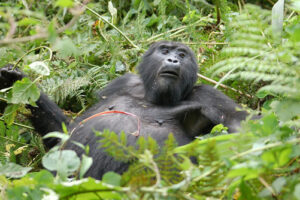 Fortunately, the story of gorilla conservation has been a success. Their intriguing nature and endangered status has made it easy to attract funding from wildlife conservation organizations. The main international organization working to protect mountain gorillas is the International Gorilla Conservation Programme (IGCP). This programme was founded in 1991 and is a combined effort of the World Wide Fund for Nature, Fauna & Flora International and African Wildlife Foundation. These organizations have been very generous and have made resources available for the protection of the mountain gorillas.
Fortunately, the story of gorilla conservation has been a success. Their intriguing nature and endangered status has made it easy to attract funding from wildlife conservation organizations. The main international organization working to protect mountain gorillas is the International Gorilla Conservation Programme (IGCP). This programme was founded in 1991 and is a combined effort of the World Wide Fund for Nature, Fauna & Flora International and African Wildlife Foundation. These organizations have been very generous and have made resources available for the protection of the mountain gorillas.
Mountain Gorilla Trekking
The cost of a gorilla tour is expensive but an encounter with mountain gorillas is the ultimate wildlife experience. Whereas a safari to spot the big five is great, nothing beats watching mountain gorillas in their natural habitat – Gorillas are our relatives. It is estimated that only about 1000 Mountain gorillas now survive in the wild – mountain gorilla permits sell like hot cake. Half of these are found in Uganda and the other half shared by Rwanda and DR Congo. Because of their small remaining overall population worldwide, Mountain gorillas are considered endangered by organizations like the International Union for Conservation of Nature.
The debate about which country is best for a gorilla safari is subject to individual opinion (even biases) and continues without conclusion. In our experience running safaris, each country has advantages over the other and the final decision on where to go rests with an individual. Some of our clients decide to see the gorillas in both Rwanda and Uganda to experience the differences tracking mountain gorillas in two countries.
Only about 20 percent of mountain gorillas are habituated. Mountain gorilla habituation is a two year process of allowing time for a 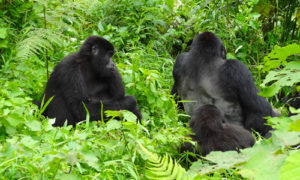 particular group to get used to humans in their midst. Non-habituated mountain gorillas are unpredictable and visitors are not allowed near them. When is the best time to go for a gorilla tour? Mountain Gorilla tracking involves passing through dense forest, steep hills and mud-filled pathways. Normal gorilla tracking and the even more adventurous gorilla habituation experience can be done throughout the year. However the best time for a gorilla safari is just after the rainy season has ended. Around this time, the countryside and gorilla parks are still stunning green and less muddy. How long does it take to track gorillas? Depending on the gorilla family you choose, the activity may take anywhere between half an hour to 8 hours. We recommend that you prepare yourself physically and psychologically for your gorilla trekking adventure. There is a packing list and accommodation options that we usually recommend to all visitors preparing to track mountain gorillas. The guides and wardens at the different parks will usually brief you about the requirements for gorilla tracking before you head out to the forest. What are the chances of seeing the gorillas? Well, we cannot guarantee that you will see the primates. However we have never heard of anyone who came back without seeing them. The chances of seeing them are over 90%. After your gorilla watching adventure, remember that there are several other activities that you can engage in. For a start, there is visiting the Dian Fossey tomb to learn about her gorilla protection and conservation efforts and what she had to say about ethical issues concerning gorilla trekking. The gorilla parks are also inhabited by other primates like chimpanzee, baboons and monkeys. The countries of East Africa are blessed with great tourism resources. You can go on a safari to view other animals in other national parks and reserves. If you love nature walks, white water rafting, cultural visits, bird watching and mountain hiking, East Africa is the place for you. Mission Africa Safaris has tailor made packages that combine gorilla safaris with other activities.
particular group to get used to humans in their midst. Non-habituated mountain gorillas are unpredictable and visitors are not allowed near them. When is the best time to go for a gorilla tour? Mountain Gorilla tracking involves passing through dense forest, steep hills and mud-filled pathways. Normal gorilla tracking and the even more adventurous gorilla habituation experience can be done throughout the year. However the best time for a gorilla safari is just after the rainy season has ended. Around this time, the countryside and gorilla parks are still stunning green and less muddy. How long does it take to track gorillas? Depending on the gorilla family you choose, the activity may take anywhere between half an hour to 8 hours. We recommend that you prepare yourself physically and psychologically for your gorilla trekking adventure. There is a packing list and accommodation options that we usually recommend to all visitors preparing to track mountain gorillas. The guides and wardens at the different parks will usually brief you about the requirements for gorilla tracking before you head out to the forest. What are the chances of seeing the gorillas? Well, we cannot guarantee that you will see the primates. However we have never heard of anyone who came back without seeing them. The chances of seeing them are over 90%. After your gorilla watching adventure, remember that there are several other activities that you can engage in. For a start, there is visiting the Dian Fossey tomb to learn about her gorilla protection and conservation efforts and what she had to say about ethical issues concerning gorilla trekking. The gorilla parks are also inhabited by other primates like chimpanzee, baboons and monkeys. The countries of East Africa are blessed with great tourism resources. You can go on a safari to view other animals in other national parks and reserves. If you love nature walks, white water rafting, cultural visits, bird watching and mountain hiking, East Africa is the place for you. Mission Africa Safaris has tailor made packages that combine gorilla safaris with other activities.
